The 27-inch Apple iMac Review (2011)
by Anand Lal Shimpi on May 27, 2011 2:30 AM ESTPower, Thermals and Noise
I started this review complaining about how loud the 15-inch MacBook Pro gets, but with 32x the physical volume the 27-inch iMac is near silent. Even under load the system is very quiet, almost too quiet. Apple chose a very lax fan profile which results in some very high external temperatures. The iMac takes in cool air from the bottom of the display and exhausts it up top behind the display. Playing Half Life 2 Episode Two I measured a maximum surface temperature of 125F at the exhaust vent. Again, unless you're doing something weird with the iMac on your lap this isn't an issue. Keep in mind that the Sandy Bridge CPU in the 15-inch MacBook Pro carries a 45W TDP and what's in the iMac is either 65W or 95W. Add in a larger, hotter hard drive and potentially a beefier GPU and you have a recipe for a pretty warm machine.
| 2011 iMac Power Usage | ||||||
| 27-inch iMac (Mid 2011) | Idle | Cinebench R11.5 | Half Life 2 Episode Two | |||
| Minimum Brightness | 54.1W | 108.3W | 149.0W | |||
| 50% Brightness | 86.6W | 141.6W | 180.0W | |||
| 100% Brightness | 144.5W | 198.3W | 240.0W | |||
With a large integrated display power consumption obviously varies depending on brightness. At idle, power consumption ranges from 54W to 144W. Under load the range quickly gets ever higher. I measured max system power consumption at 240W running Half Life 2 Episode Two.
Power consumption isn't out of control but you've got a billion transistor CPU, a 1.7B transistor GPU and a high resolution 27-inch display + backlight - it's going to draw some power.
Performance
Having never previously been a fan of the iMac, I don't actually have any historical performance data to compare to. What I do have however are scores from Mac Pros and of course the MacBook/MacBook Pro lines from the past couple of years.
Adobe Photoshop CS4 Performance
The Retouch Artists Speed Test we use for our CPU testing under Windows also works under OS X. We're running the exact same benchmark here, basically performing a bunch of image manipulations and filters and timing the entire process.
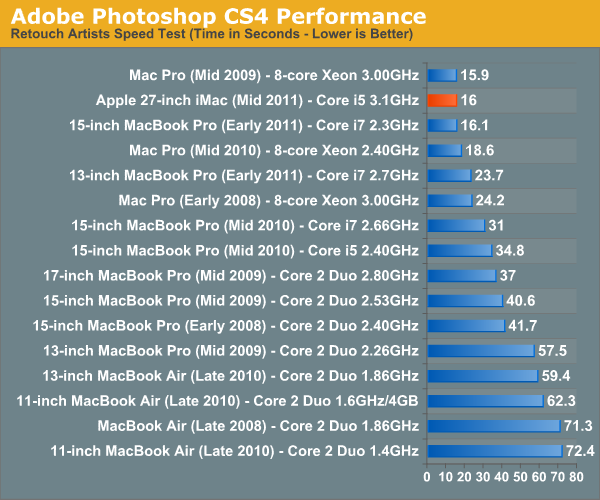
The high-end 27-inch iMac is a very capable Photoshop machine. A hair faster than the new MacBook Pro, the iMac delivers the same performance as an 8-core Mac Pro from 2009 or 2010.
Aperture 2 RAW Import
For my Aperture test I simply timed how long it took to import 203 12MP RAW images into the library.
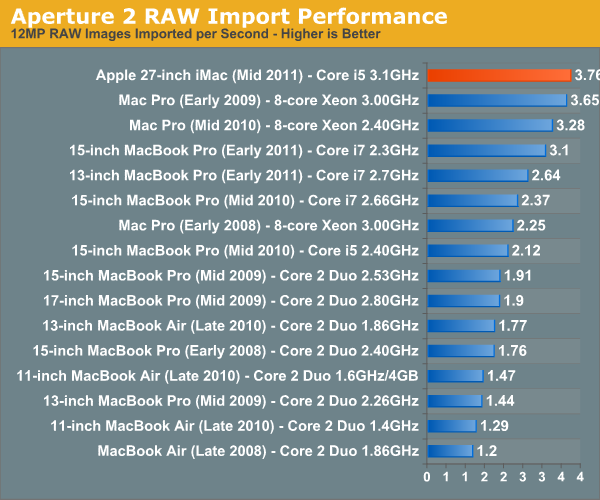
We have a new winner here! The MacBook Pros were always limited by their slower 2.5" hard drive, but the iMac with Sandy Bridge in additional to a speedier disk give us better image import performance than the '09 and '10 Mac Pros. I told you this thing was fast.
Cinebench R10 & 11.5
I’m a fan of the Cinebench tests because they lets me show off both single and multithreaded performance in the same workload. First, the single threaded performance:
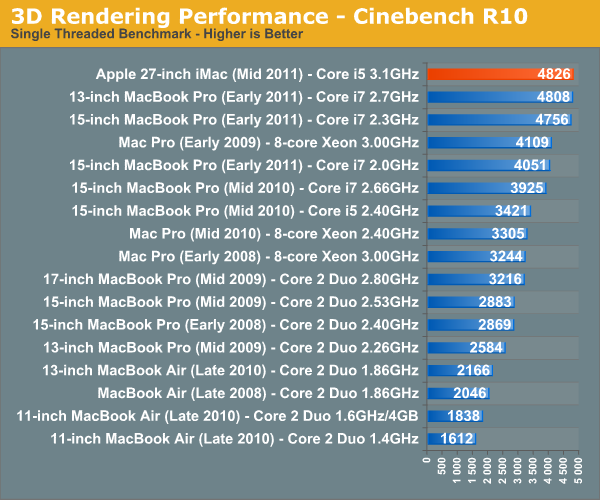
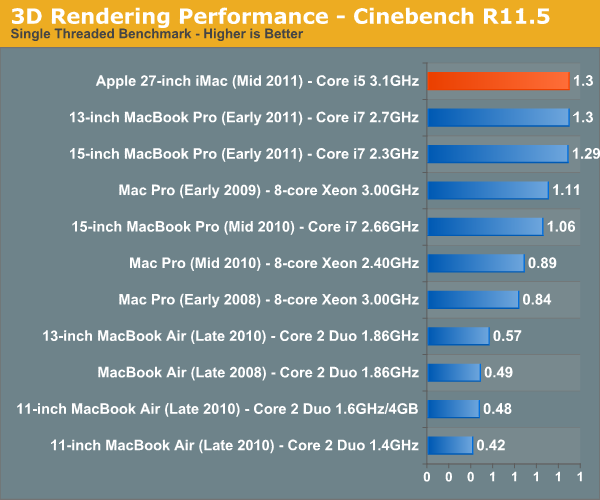
Sandy Bridge quad-core CPUs make no sacrifices. You get excellent single threaded performance which means general OS usage, launching applications and even rendering most web pages happens as fast as physically possible as the other cores are power gated and asleep. Start multitasking however and you'll see the Core i5 in this machine is no slouch:
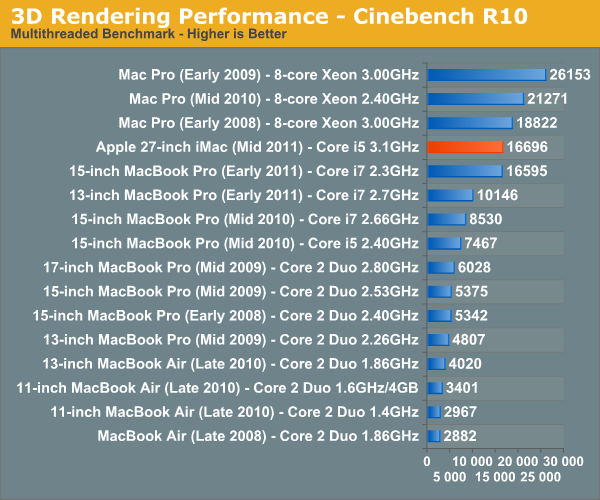
There's still no replacement for more cores when it comes to heavily threaded applications, the past three years of 8-core Mac Pros are still faster than the new 27-inch iMac here. I suspect the upgraded Core i7 would at least let the iMac beat the 2008 Mac Pro thanks to Hyper Threading, but the other two systems are simply out of reach. For those users, you're better off waiting for the Sandy Bridge-E Mac Pro update expected sometime in Q4.
You'll notice in Cinebench R10 the 15-inch MacBook Pro is nipping at the heels of the new iMac. Chalk that up to the larger L3 cache and Hyper Threading, both advantages enjoyed by the MacBook Pro. Look at what those advantages do in Cinebench R11.5's multithreaded test:
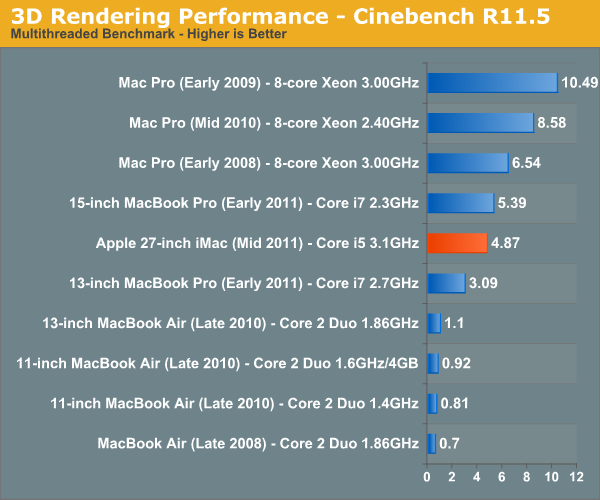
Here the MacBook Pro actually gains on the iMac. More threads and more cache are better suited for the Cinebench workload. If you do a lot of offline 3D rendering and you want the iMac, I'd suggest upgrading to the Core i7-2600 that Apple offers. You get a not insignificant boost in clock speed but more importantly, Intel switches on Hyper Threading which gives you twice as many threads.
Quicktime H.264 Video Encoding
Our final benchmark is more consumer focused. Here I'm taking an XviD and converting it to an iPhone-supported H.264 format.

QuickTime doesn't make tremendous use of all cores all of the time, and thus the MacBook Pro loses its threading advantage. The iMac is our new champion of this test.










139 Comments
View All Comments
joe_dude - Saturday, May 28, 2011 - link
But the thing's essentially a 3-year old PC. Why the heck would I want to pay more to downgrade?Of course Macs hold their resell value... it's not for gaming, so even a 5 year old Mac seem pretty fast using regular apps.
Even if it can be used as just a monitor, who the heck wants the extra dead weight? All-in-ones will always be a compromise. The point of having a desktop PC is *not* to compromise. Otherwise, a laptop can do the job.
Kristian Vättö - Saturday, May 28, 2011 - link
Good luck finding a Sandy Bridge CPU and AMD 6000-series graphics in a 3-year-old PC.A LOT fits between regular apps and gaming. Photo, music and video editing are the first that come to my mind. For some people, Macs are the preferred option due to Logic and Final Cut. When you don't have the $ for Mac Pro, iMac is your best option. In the end, iMac is far more powerful than MBPs or other laptops.
Sure, AIO form factor has its downsides but it's pretty clear that Apple has never been interested on enthusiasts. For an Average Joe, iMac is a brilliant machine, which explains why it sells so well too.
joe_dude - Saturday, May 28, 2011 - link
Don't be hoodwinked. Any 3-year old SLI rig would beat the pants off this thing. Remember, it's a _mobile_ CPU with a _mobile_ GPU; a laptop pretending to be a desktop.Any middle-of-the-road SFF/ITX machine with a Radeon 6850 would beat the pants off this thing. This thing is all about form over function. Save the money and get a 30" Dell monitor instead.
Kristian Vättö - Saturday, May 28, 2011 - link
I would like to know where you can find a 3.4GHz quad core mobile CPU. The CPUs are standard desktop parts and i7-2600 is actually one of the fastest CPUs that is available today.Your 3-year-old SLI rig beat or come close in GPU performance but the iMac would run circles around it in CPU bound tests. If you talk about performance, then you must include every area, not just gaming and graphics tests. Or then specify that you are only talking about gaming performance.
iMac's value isn't that bad when you consider the value of the screen. 30" monitor will cost you at least 1000$ so that leaves you another 1000$ for the actual computer. Sure, that is more than enough to get the similar components but the iMac won't end up being more than ~200$ more expensive (which is pretty good when talking about Apple).
Nobody is forcing you to buy an iMac so that is why I don't get why you are complaining. Clearly, there are people who want one, even if it is a compromise. You can stick with your PC if that is what you prefer.
joe_dude - Saturday, May 28, 2011 - link
Ah yes, you're right on the CPU. For some reason I thought the dual channel 1155 socket meant it was a mobile CPU.The Dell version of the 27" can be had ~$800. Of course, retail price is ~$1000, and Apple wouldn't charge less, of course.
The 3.4 GHz i7 option costs extra (is it really $500???), so we're talking a ~$1700 PC (sans monitor). We're talking a full out i7 SLI rig vs. a weaksauce iMac for that price.
I'm a gamer, but not crazy enough to spend that on an all-in-one!
Kristian Vättö - Saturday, May 28, 2011 - link
I think you should really check your facts before you post. The i7 option in iMac is 200$, not 500$. Sure, it is still overpriced but BTOs in general are. The iMac can also be had for less when you look at resellers like MacMall so IMO, the only fair comparison is to look at retail prices.For 1200$, you can build a nice PC but definitely not an SLI system (unless you go with lower-end GPUs, though that kills the idea of SLI IMO).
If we wanted to be fair, we should compare the iMac to an OEM PC, not self-built one. Why? Because you are paying for the labor and service in the iMac as well. That is why OEM PCs cost more than the ones you build on your own. I know the joy of building your own computer is unbeatable and I love it too but when comparing things, you have to understand where the costs come from. It's a whole new question whether it is worth it for you to pay the extra for service etc.
I'm not trying to sell you an iMac but to make you understand where the costs come from and in the end, why the iMac isn't that bad value. For gamers, the iMac is and will always be a very compromised system.
donnyg - Saturday, May 28, 2011 - link
As SmithJ mentioned, a i7 computer with PCIe 16x/4x is only around $750 USD and that's including a GPU.You can easily get 2x HD6950x/6970s which do much better in that resolution anyway because of the VRAM requirements.
KoolAidMan1 - Sunday, May 29, 2011 - link
Throw in the same 2560x1440 IPS display and you're adding at least another $1000 to the whole package. Then there's operating system and the bundled software, and the fact that all-in-ones from any PC builder costs more than a standard ATX based PC.Given everything involved, the iMacs are actually a pretty good deal. Really fast, amazing display, tiny footprint, and silent. I still build my own PCs and I'll never give that up, but I love having it plugged into my iMac as a display and using both.
smithj - Saturday, May 28, 2011 - link
My shop runs iMacs because they're just so good with size and noise - we're really damned pleased that we've ditched the old noisy workstations and they're fast enough for what we want to do!But he's kind of right. For a consumer, iMacs aren't the best of value. A small mATX computer with an i7 2600 (what 99% of people going to do with an i7 I don't know) and an AMD HD 5850 only costs around $700, and this isn't even looking around. Throw in a 27" Ultrasharp or ACD and your whole computer is going to cost only $1500-1700.
They're popular because they're:
- Small
- Amazing looking
- Perform well enough
- Quiet
- Covered by the best consumer warranty in the market
- Good out of the box, no extra work required
Its got nothing to go with specs, most people who buy them frankly don't care about the specs. $500-700 extra to pay for a generally weaker computer is a bit annoying but I'm getting old and frankly the warranty service, ease of use, and lack of noise is loved by all.
smithj - Saturday, May 28, 2011 - link
We can't edit post. The point I'm making is that in a price/spec game, the iMacs are nowhere near as good as DIY PCs but there are some things that can't be directly put in a small HTML table.Apple to this day seems to be one of the few companies, if not the only, who understands this important factor.